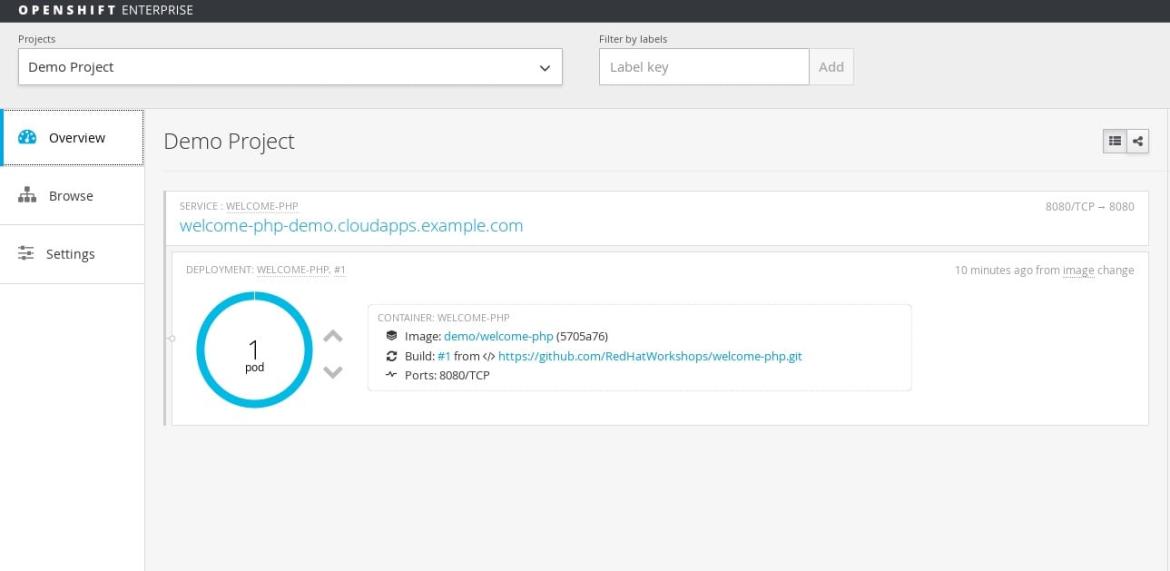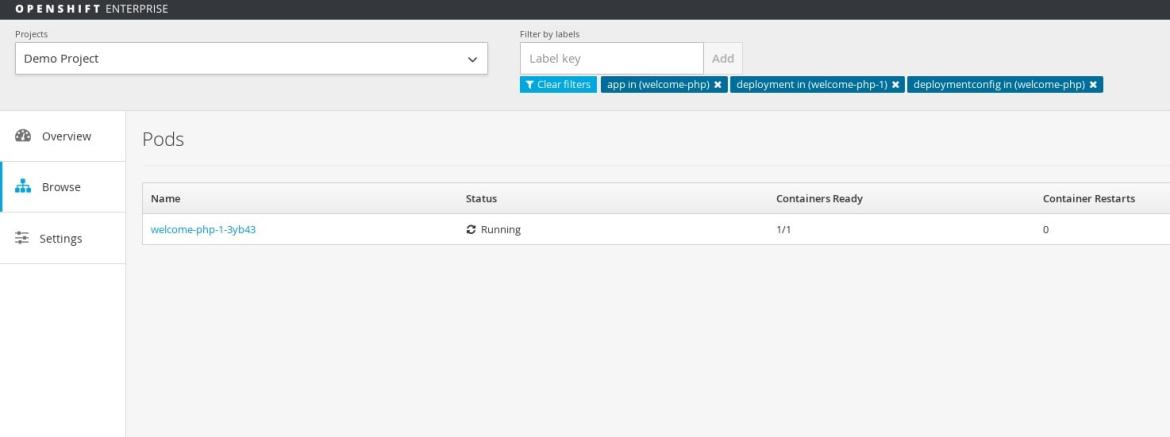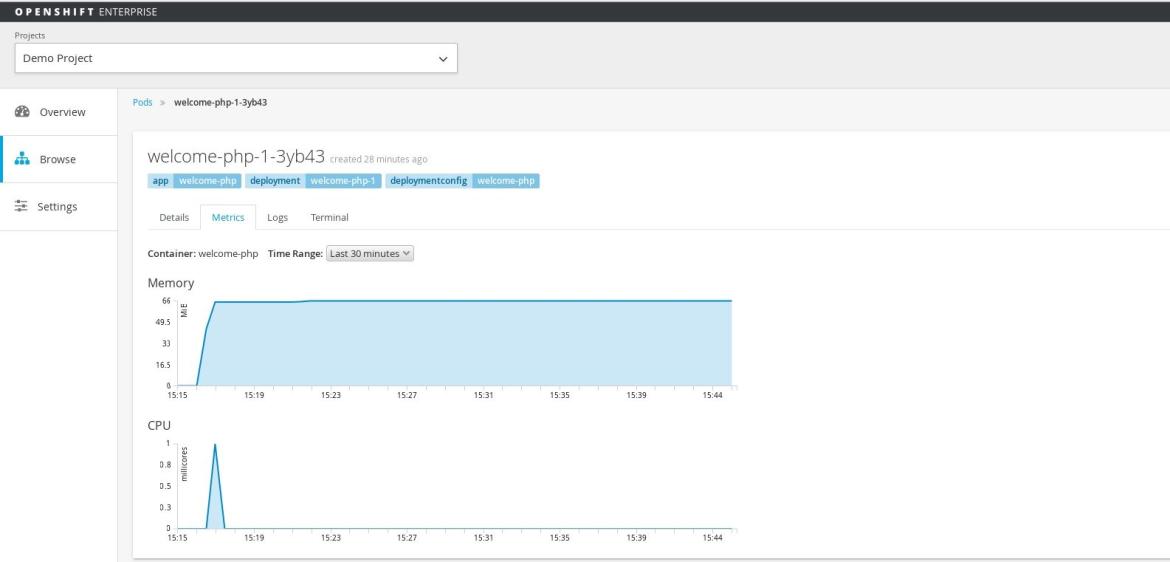Red Hat blog
This post was written by Christian Hernandez, Solution Architect of the OpenShift Tiger Team.
OpenShift 3.1 provides a lot of new features and upgrades one of which is the introduction of a "horizontal pod autoscaler". The pod autoscaler tells OpenShift how it should scale up or down the replication controller (or deployment configuration) automatically. Scaling is based on metrics collected from the pods that belong to that specific replication controller.
NOTEs:
- Pod autoscaling is currently a Technology Preview feature.
- Currently, the only metric supported is CPU Utilization.
- The OpenShift administrator must first enable Cluster Metrics before you can enable autoscaling.
- The OpenShift administrator must also enable Resource Limits on the project.
Create An Application
I will start off by creating a simple PHP applicaiton under my demo project.
$ oc project
Using project "demo" from context named "demo/ose3-master-example-com:8443/demo" on server "https://ose3-master.example.com:8443".
$ oc new-app openshift/php~https://github.com/RedHatWorkshops/welcome-php.git
The build will automatically starts. It will take a little while but once it's done, go ahead and expose the service to create a route.
$ oc expose svc welcome-php
route "welcome-php" exposed
$ oc get routes
NAME HOST/PORT PATH SERVICE LABELS INSECURE POLICY TLS TERMINATION
welcome-php welcome-php-demo.cloudapps.example.com welcome-php app=welcome-php
At this point login to the web console and select the "demo" project. The overview page should look like this:

Click on the circle graph and it should show you a list of pods (currently only one) for this deployment.

Go ahead and click on the pod name (in this case it's welcome-php-1-0jihu) to bring up the details page about the pod.
There should be a tab that says Metrics. Go ahead and click on that to view the metrics for this paticualr pod. The CPU metrics you see will be used to scale this application.

Set up Autoscaling
Once the HorizontalPodAutoscaler object is set up; the autoscaler begins to query Heapster for CPU Utilzation on the pods. It will take some time before it collects the initial metrics.
When the metrics are available, the autoscaler compares the current CPU utilization with the desired CPU utilization, and scales up or down accordingly. The scaling will occur at a regular interval, but it may take a little bit before the metrics make their way into Heapster.
Depending on what you're applying the autoscaler to...
- Replication controllers - this scaling corresponds directly to the replicas of the replication controller.
- Deployment configs - this will scale the latest deployment, or the replication controller template in the deployment config if none is present.
We will use this sample yaml config:
apiVersion: extensions/v1beta1
kind: HorizontalPodAutoscaler
metadata:
name: frontend-scaler
spec:
scaleRef:
kind: DeploymentConfig
name: welcome-php
apiVersion: v1
subresource: scale
minReplicas: 1
maxReplicas: 10
cpuUtilization:
targetPercentage: 5
A few things to note:
name- An arbitrary name for this specific autoscaler (in this instance it'sfrontend-scaler)kind- Which object we want to scale (in this case it's theDeploymentConfig)name- Name of theDeploymentConfigwe are scalingminReplicas- Minimum amount of pods to runmaxReplicas- Maximum number of pods to scale totargetPercentage- The percentage of the requested CPU that each pod should ideally be using
In this instance we are using 5% in order to test. Realistically you will use something like 70%-80%
Create the autoscaler
$ oc create -f scaler.yaml
horizontalpodautoscaler "frontend-scaler" created
View the status of a horizontal pod autoscaler.
$ oc get hpa
NAME REFERENCE TARGET CURRENT MINPODS MAXPODS AGE
frontend-scaler DeploymentConfig/welcome-php/scale 5% <waiting> 1 10 5s
At first it should show <waiting> but after a while it sould show the correct metric
$ oc get hpa
NAME REFERENCE TARGET CURRENT MINPODS MAXPODS AGE
frontend-scaler DeploymentConfig/welcome-php/scale 5% 0% 1 10 1m
Test Autoscaling
I will be using Apache Benchmark (the ab command) to simulate load on my applicaiton.
$ ab -n 100000000 -c 75 http://welcome-php-demo.cloudapps.example.com/
At first you should only see one pod
$ oc get pods
NAME READY STATUS RESTARTS AGE
welcome-php-1-0jihu 1/1 Running 0
It takes a while for the metrics to reach Heapster; so you can run
$ oc get hpa --watch
After a while you should see it reach the threshold
$ oc get hpa
NAME REFERENCE TARGET CURRENT MINPODS MAXPODS AGE
frontend-scaler DeploymentConfig/welcome-php/scale 5% 46% 1 10 5m
You should now see 10 pods spin up
$ oc get pods
NAME READY STATUS RESTARTS AGE
welcome-php-1-0jihu 1/1 Running 0 1h
welcome-php-1-3ag79 1/1 Running 0 47s
welcome-php-1-6emrs 1/1 Running 0 47s
welcome-php-1-chkmz 1/1 Running 0 47s
welcome-php-1-dwrnz 1/1 Running 0 47s
welcome-php-1-l2ood 1/1 Running 0 48s
welcome-php-1-os4mu 1/1 Running 0 47s
welcome-php-1-rb8lb 1/1 Running 0 47s
welcome-php-1-rv1k2 1/1 Running 0 47s
welcome-php-1-tm7rn 1/1 Running 0 47s
Once your ab command finishes you should see your oc get hpa --watch command go down until it gets back to 0%
$ oc get hpa
NAME REFERENCE TARGET CURRENT MINPODS MAXPODS AGE
frontend-scaler DeploymentConfig/welcome-php/scale 5% 0% 1 10 24m
Now your pods should be back down to 1
$ oc get pods
NAME READY STATUS RESTARTS AGE
welcome-php-1-rb8lb 1/1 Running 0 19m
Summary
In this article we went over how to enable autoscaling for your application in the newest release of OpenShift.
Author
Christian Hernandez
Solution Architect
US CSO Solution Architect- OpenShift Tiger Team
@christianh814
About the author
Christian Hernandez currently leads the Developer Experience team at Codefresh. He has experience in enterprise architecture, DevOps, tech support, advocacy, software engineering, and management. He's passionate about open source and cloud-native architecture. He is an OpenGitOps Maintainer and an Argo Project Marketing SIG member. His current focus has been on Kubernetes, DevOps, and GitOps practices.

